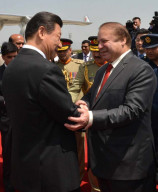
If only we can, in good time, equip our youth bulge with appropriate skills, especially in the knowledge-based specialities and enhance at the same time their productivity, Chinese businesspersons are likely to come to Pakistan to explore investment avenues in finance, banking, power, alternative energy, information technology, engineering goods, textile machinery, agriculture, agro-based industry, food, fruit processing, packaging, livestock and dairy farming. These industries are expected to be set up in the economic zones being planned along the three corridors (eastern, central and western). However, in order for these economic zones to be economically viable, Pakistan would need to develop its supply chains en route.
This would mean introducing innovative trade policies that would push up import duties on finished goods to punishing levels, while at the same time resetting the rupee exchange rate at its realistic value, while bringing down import duties on raw materials, intermediaries and products in knock-down conditions to almost zero, to be warehoused for value-addition and then trans-shipped both ways on the CPEC.
And there is also the possibility that if we could offer the right kind of trained manpower, China would consider re-locating some of its manufacturing units in Pakistan; ones that are likely to become, at some future date, uneconomical at their original locations due mainly to escalation in labour costs. This is how the Asian Tigers became what they are today. In the late 1960s and early 1970s, the entrepreneurs in the US found the labour costs at home to be eating into their profit margins and therefore turned to East Asian countries with their capital and technology, used the cheap labour of host countries for fabrication and exported the finished goods back home to the US. In time, the East Asian countries saw their economies growing by leaps and bounds, led by exports, while consumers in the US and Europe found all kinds of luxury and semi-luxury goods, along with the essentials, within the reach of incomes of even those at the lowest rungs of society.
According to a study conducted by Dr Shabir Ahmed Khan, Assistant Professor, Area Study Centre, Peshawar University, the Pakistani apparel industry offers one of the lowest cost options globally: “The cost differential can be as high as 25 per cent, substantial in an industry that generally operates on low margins for the exporter. For instance, a hooded sweat shirt is made at the rate of $12 per piece in China, in Pakistan it costs $9 to $10. Similarly, a pair of jeans costs $10 in China while in Pakistan it costs $8 to $8.5, because the labour cost in Pakistan is less than in China, India and Vietnam. Pakistan has its own cotton supply and fabric and has more small and medium-size factories. China, after the US, is the second largest importer of Pakistan‘s textiles which is $1.527 billion, according to trade statistics for the last fiscal year. China mainly buys cotton yarn and cotton fabrics. The entrepreneurs in Pakistan also need to understand the Chinese market and avail the opportunities provided under the China-Pakistan Free Trade Agreement. For instance, Pakistan is the cheapest supplier of bed wear in the world and China does not levy any duty on bed wear imports from Pakistan. With the up-gradation of 335km section of the Karakoram Highway from Gilgit to the Khunjerab Pass, making the highway an all-weather connection, bilateral trade as well as trade with the Central Asian region is bound to pick up and open fresh avenues for commerce on the new Silk Route. The expected revenues from oil and gas transit and land-to-sea trade via Pakistan can total around $1,000,000 per year.”
Published in The Express Tribune, June 24th, 2015.
Like Opinion & Editorial on Facebook, follow @ETOpEd on Twitter to receive all updates on all our daily pieces.






















1714029027-0/Tribune-Collage-Feature-Images-(11)1714029027-0-270x192.webp)
1714027629-0/Ranbirtransformation-(1)1714027629-0-270x192.webp)




















COMMENTS (3)
Comments are moderated and generally will be posted if they are on-topic and not abusive.
For more information, please see our Comments FAQ